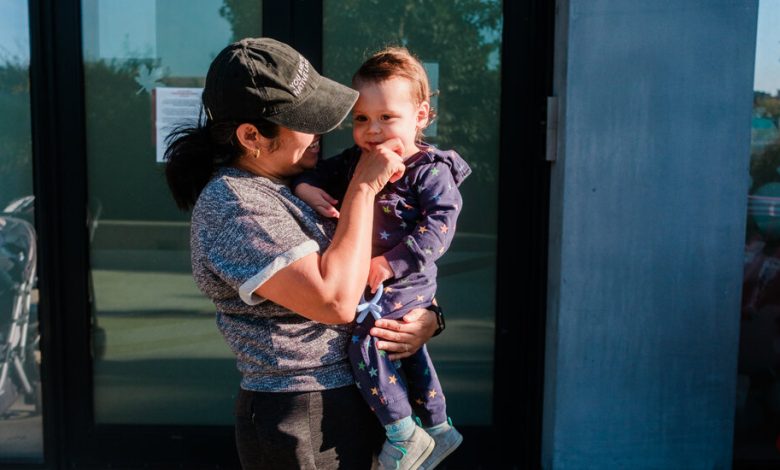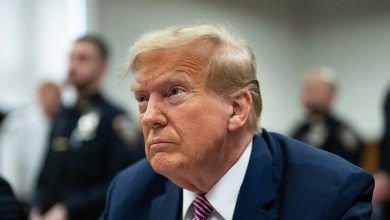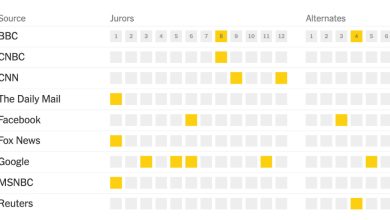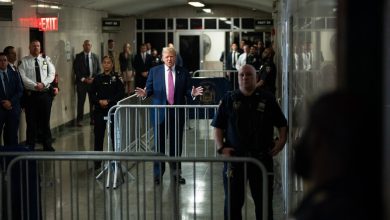In an Expensive City, Who Should Get Free Preschool?

Raising a family in one of the most expensive cities in the world involves some advance planning. So when Monika Navarro and her husband had a child last year in Boerum Hill, Brooklyn, they budgeted for a few years of expensive child care — banking on the idea that New York City’s free prekindergarten program would take over when their son turned 3. The expected savings: about $13,000.
But soon after Mayor Eric Adams took office, he cut funding for the program, known as 3-K for All, which had been a signature promise of his predecessor, Bill de Blasio. The year of free care she once thought was guaranteed, Ms. Navarro said, could be the difference between her family staying in New York or moving to a less expensive city.
“I do feel like we’ll have to step back and look at these costs and say — does this make sense?” said Ms. Navarro, who described herself as part of the city’s “shrinking middle class.”

Ms. Navarro worked from home after dropping her toddler at a local day care site. She recently switched programs to try to give him a better shot at getting a 3-K seat.Credit…Gabriela Bhaskar for The New York Times
The major shift on 3-K raises a fundamental question: Should access to one of the most broadly popular entitlements in New York City should be available to everyone — or concentrated in the city’s neediest neighborhoods?
The debate over whether local governments should provide social services to families who are not acutely struggling has broad implications for U.S. cities, as pandemic-era federal funding dries up and mayors tighten budgets. It is a particularly urgent issue in New York City, where Mr. Adams’s administration struggles to offer essential services for the most vulnerable residents, and even families bringing in over six figures find it increasing hard to get by.
Adams administration officials have pointed to what they consider the city’s dire financial straits as part of the reason for the cuts, along with the large number of unfilled 3-K seats in some neighborhoods.
But the mayor is facing pressure to make life easier for working families, and cuts to the free preschool program amplify the challenges that New Yorkers confront.
“There’s no question that New York City is expensive, but people were, up to a point, willing to make that trade-off,” said James Parrott, the director of economic and fiscal policy at the New School’s Center for New York City Affairs.
If the city continues to cut back on 3-K and other services, though, he said, “at some point, people’s willingness to make that trade-off reaches a tipping point.”
A mismatch of supply and demand
While preschool for 4-year-olds is guaranteed for all New York City families who want a spot, the 3-K program is now stuck in a kind of limbo, short of being universal.
Though 43,000 children were enrolled at the end of the last school year, thousands of seats remain unfilled — even while New Yorkers across the socio-economic spectrum are struggling to find and pay for child care. Adams officials have criticized the previous administration for not moving aggressively enough to shift seats into neighborhoods where demand is highest, while former de Blasio staff members say that City Hall is intentionally weakening the program by not promoting it, leaving many parents unaware that it is even available.
The city still does not have a permanent funding source for 3-K. The previous administration used pandemic-era federal dollars to expand it into most neighborhoods after first rolling it out in low-income areas, a strategy that Mr. Adams did not continue.
Still, many parents mark January of the year their child turns 3 as a milestone: the moment they can apply for 3-K seats. Families can request seats for their children at up to 12 sites, in public schools, child care care centers, day cares run out of private homes or community organizations that have received funding to offer the program.
The Department of Education website warns parents that “seats are limited” in a lottery system that gives children preference for slots in their local school district.
In some low-income neighborhoods — including Brownsville, Brooklyn; Harlem; and the South Bronx — there are many more seats available than there are applications. Elsewhere — particularly in northeast and western Queens and southern Brooklyn — there is a frenzy among in-the-know-families to grab a handful of open slots.
In interviews, parents used phrases like “mirage” and “La-La Land” to describe the 3-K landscape. Some said they were frantically comparing notes on the playground about which day care programs to enroll their infants and toddlers in, searching for those most likely to also eventually provide them a 3-K seat. Some said they were trying to time the birth of a second child to when the first might be starting 3-K, or were considering moving to neighborhoods with more availability.
That kind of gaming of the system is exactly what universal access was created to avoid, said W. Steven Barnett, senior co-director of the National Institute for Early Education Research.
“It’s not just people in poverty that have trouble paying for this,” he said.
Since the program began in 2014, the city has marketed universal prekindergarten as a two-for-one: an educational necessity preparing children for kindergarten while also saving parents thousands of dollars a year and making it easier for them to return to work.
That it would be available to every family who wanted it was baked into the promise.
“Universality means friction-free, it means ease, it means convenience,” Mr. de Blasio said in an interview.
It has been a rare city program where results at least begin to resemble the lofty campaign pledges. Studies have shown the city’s prekindergarten classrooms are generally high-quality, and the program has benefited its hundreds of thousands of alumni.
After Mr. de Blasio began expanding the program to 3-year-olds, mothers living in parts of the city with more 3-K seats were more likely to be in the work force full-time than mothers living in neighborhoods without them. That trend persisted even after their children graduated from the program, according to a recent report by the Robin Hood Foundation, a charity focused on fighting poverty in New York.
Adams officials have defended their decision to redirect about $568 million originally budgeted for the program’s expansion by pointing to the about 10,000 available 3-K seats that remain unfilled.
Education Department officials have emphasized the need to provide as many seats as possible to low-income families but insist they have not abandoned other parents.
“As our city faces difficult financial times, we are protecting this system and ensuring that New Yorkers with the least have a fighting chance at making it here,” Nathaniel Styer, an Education Department spokesman, said in a statement.
And where the previous administration focused much of its education agenda on expanding prekindergarten, Mr. Adams has made improving dismal literacy rates and screening for dyslexia the cornerstone of his plan for schools.
Mr. Styer said the city has made progress in shoring up 3-K over the past year: The total number of seats offered grew this year compared with 2022, and the number of families who requested but did not get a seat dropped to about 900 applicants, compared with roughly 3,000 last year.
He said families who did not get a seat at one of their preferred locations were offered any of the open slots across the city — some of which he acknowledged might require a multi-hour commute.
But former de Blasio staff members and some politicians say none of that solves the real problem: The Adams administration has largely dismantled the once-robust outreach operation created for the rollout of prekindergarten.
That office included staff members to track and manage enrollment as well as ubiquitous advertising. A staff exodus from the Education Department’s early childhood office has been the death knell for that work, former officials said, leaving some parents unaware of free preschool.
‘Suddenly it goes away’
Desiree Reid, who runs a small child care program out of her home near Co-Op City in the Bronx, recently started hearing from local parents that their older children were getting spots in prekindergarten, but their younger siblings, including 3-year-olds, needed affordable options. Frustrated, Ms. Reid decided to offer 3-K herself.
Eight months and many reams of paperwork later, she was finally approved to offer extended day 3-K, which comes with federal income eligibility limits and a separate application.
Ms. Reid had plenty of interest from nearby families, but only two were able to complete their paperwork before school started.
Under Mr. de Blasio, outreach workers would have likely been on call to walk families through the process. Now, Ms. Reid must absorb that work.
“Something can be available, but if people don’t know about it, then they’re not going to use it,” she said. “And if it’s not utilized, then suddenly it goes away.”
Critics say the solution is to make 3-K truly universal.
Mr. Adams has embraced the opposite approach in his plan for early childhood education, using a separate pot of state funding to subsidize child care vouchers for children from families of four earning less than $100,000. The vouchers can be used for different types of care for children as young as 6 weeks and as old as 13.
But early childhood experts are skeptical. Making prekindergarten seats available for all families, they said, removes stigma and barriers to entry, builds political will to keep programs even during moments of austerity and creates pressure to maintain high-quality programs.
The idea behind New York City’s universal prekindergarten program was to create two new grades that would become part of the broader public school system, which would in turn help bring more middle-class families into the schools.
Ms. Navarro, the Brooklyn mother, is eager to be a public school parent. But first, she has had to search for the right spot to enroll her son, Joaquín, who is nearly 2, in day care.
She finally found a high-quality program with a diverse group of children that seemed poised to offer 3-K. But now, that center is not planning to provide the program, and it is a tossup whether he will win a spot in what has become a high-stakes lottery for seats nearby.
Ms. Navarro decided to pull him out of his original program and enroll him in a different center offering 3-K. She has been told that Joaquín has a 50 percent chance of getting one of those dozen or so seats. It is a gamble she is willing to take.



